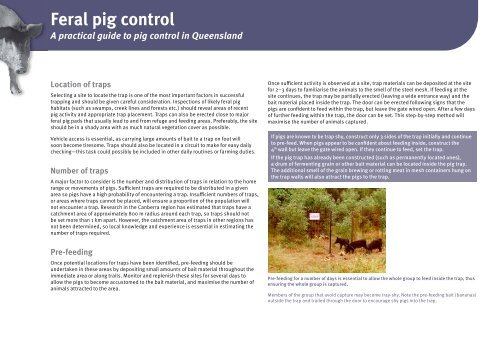Ipa Feral Pig Control Manual - Department of Primary Industries ...
Ipa Feral Pig Control Manual - Department of Primary Industries ...
Ipa Feral Pig Control Manual - Department of Primary Industries ...
You also want an ePaper? Increase the reach of your titles
YUMPU automatically turns print PDFs into web optimized ePapers that Google loves.
<strong>Feral</strong> pig control<br />
A practical guide to pig control in Queensland<br />
Location <strong>of</strong> traps<br />
Selecting a site to locate the trap is one <strong>of</strong> the most important factors in successful<br />
trapping and should be given careful consideration. Inspections <strong>of</strong> likely feral pig<br />
habitats (such as swamps, creek lines and forests etc.) should reveal areas <strong>of</strong> recent<br />
pig activity and appropriate trap placement. Traps can also be erected close to major<br />
feral pig pads that usually lead to and from refuge and feeding areas. Preferably, the site<br />
should be in a shady area with as much natural vegetation cover as possible.<br />
Vehicle access is essential, as carrying large amounts <strong>of</strong> bait to a trap on foot will<br />
soon become tiresome. Traps should also be located in a circuit to make for easy daily<br />
checking—this task could possibly be included in other daily routines or farming duties.<br />
Number <strong>of</strong> traps<br />
A major factor to consider is the number and distribution <strong>of</strong> traps in relation to the home<br />
range or movements <strong>of</strong> pigs. Sufficient traps are required to be distributed in a given<br />
area so pigs have a high probability <strong>of</strong> encountering a trap. Insufficient numbers <strong>of</strong> traps,<br />
or areas where traps cannot be placed, will ensure a proportion <strong>of</strong> the population will<br />
not encounter a trap. Research in the Canberra region has estimated that traps have a<br />
catchment area <strong>of</strong> approximately 800 m radius around each trap, so traps should not<br />
be set more than 1 km apart. However, the catchment area <strong>of</strong> traps in other regions has<br />
not been determined, so local knowledge and experience is essential in estimating the<br />
number <strong>of</strong> traps required.<br />
Pre-feeding<br />
Once potential locations for traps have been identified, pre-feeding should be<br />
undertaken in these areas by depositing small amounts <strong>of</strong> bait material throughout the<br />
immediate area or along trails. Monitor and replenish these sites for several days to<br />
allow the pigs to become accustomed to the bait material, and maximise the number <strong>of</strong><br />
animals attracted to the area.<br />
Once sufficient activity is observed at a site, trap materials can be deposited at the site<br />
for 2–3 days to familiarise the animals to the smell <strong>of</strong> the steel mesh. If feeding at the<br />
site continues, the trap may be partially erected (leaving a wide entrance way) and the<br />
bait material placed inside the trap. The door can be erected following signs that the<br />
pigs are confident to feed within the trap, but leave the gate wired open. After a few days<br />
<strong>of</strong> further feeding within the trap, the door can be set. This step-by-step method will<br />
maximise the number <strong>of</strong> animals captured.<br />
If pigs are known to be trap shy, construct only 3 sides <strong>of</strong> the trap initially and continue<br />
to pre-feed. When pigs appear to be confident about feeding inside, construct the<br />
4 th wall but leave the gate wired open. If they continue to feed, set the trap.<br />
If the pig trap has already been constructed (such as permanently located ones),<br />
a drum <strong>of</strong> fermenting grain or other bait material can be located inside the pig trap.<br />
The additional smell <strong>of</strong> the grain brewing or rotting meat in mesh containers hung on<br />
the trap walls will also attract the pigs to the trap.<br />
Pre-feeding for a number <strong>of</strong> days is essential to allow the whole group to feed inside the trap, thus<br />
ensuring the whole group is captured.<br />
Members <strong>of</strong> the group that avoid capture may become tray-shy. Note the pre-feeding bait (bananas)<br />
outside the trap and trailed through the door to encourage shy pigs into the trap.
















